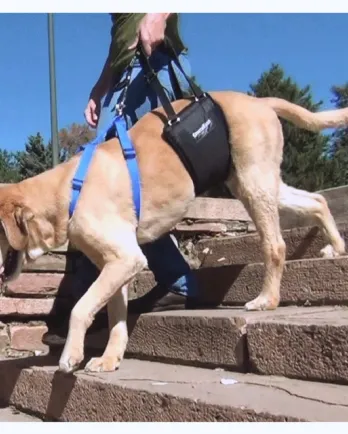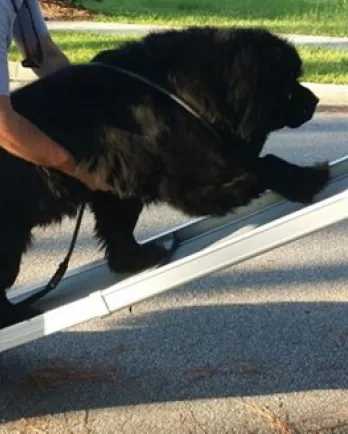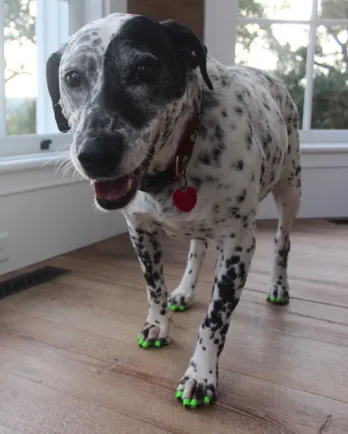9 Helpful Products for Aging Dogs by Dr. Julie Buzby, DVM
Dr. Julie Buzby, DVM, a member of Grey Muzzle's Advisory Board, is a practicing integrative veterinarian who seeks to blend the best of Western medicine, alternative therapies, and creative tools for maximum wellness in her patients, She is also the developer of ToeGrips®, devices that improve mobility in dogs by providing them with better traction. She has published numerous articles on canine health and wellness, and you can find more of her articles for Grey Matters here.
As an integrative veterinarian who treats primarily senior dogs, I’m frequently asked about products that can improve quality of life for aging dogs. Here are the top nine products I recommend for my grey-muzzled patients:
1. Omega-3 Fatty Acids
The closest thing to a panacea, omega-3 supplements can positively impact every cell in your dog’s body. Like humans, dogs cannot produce these fatty acids on their own, and must get them through diet.
Omega-3s reduce inflammation throughout the body, benefiting skin, eyes, heart, bladder, brain, and joints. I recommend this supplement for my arthritic patients, those suffering from age related brain dysfunction, vision issues, heart disease, and skin conditions. While omega-3s may be appropriate for dogs of any age, it’s obvious why they are such a good supplement for seniors.
Quality matters when purchasing supplements, so it helps to do some research. When choosing a brand, consider the sources of ingredients, concentration, and processing/quality control. Also, be sure to store the bottle properly, preferably in the refrigerator. Light, heat, and air can oxidize fatty acids, causing harmful free radicals to form, which gives the product a rancid, fishy smell.
The only significant contraindication to note is that fatty acids can increase bleeding times, so I recommend stopping them a couple weeks before a scheduled surgery.
COST: $10 to 20 per month for a 50 lb dog
2. Support and Lifting Harnesses
If you live with a dog who needs a lift to get up off the floor, or assistance walking, chances are you’ve already done damage to your back, and you’ve jerry-rigged some type of system for helping your dog. Good news! There are dozens of excellent harnesses on the market. The two that I recommend for my patients are the GingerLead ® Support and Rehabilitation Harness, and the Help ‘Em Up™ Mobility Harness. Both are of excellent quality and utilize patented technology to help dogs with weak legs have more freedom and mobility.
The Help 'Em Up is a lifting aid that straps around a dog's legs and body, and can be worn all day. The GingerLead is a walking aid that is easy to put on and take off, but not intended to be left on a dog.
When I have patients who can’t get around by themselves and require significant help to rise, I recommend the Help ‘Em Up as a semi-permanent accessory. For dogs that just need hind end support when rising or gaiting, the GingerLead is a quick on and off, ergonomic solution.
COST: for a 50 lb dog
GingerLead: ~ $60
Help ‘Em Up: ~ $100
3. Neutricks®
Neutricks®, a supplement I discovered through the recommendation of colleagues, is a fairly recent addition to my arsenal and has exceeded my expectations. Neutricks utilizes apoaequorin, a unique protein from jellyfish, to protect brain cells against aging and support cognitive function. Apoaequorin is a protein our pets’ brains need for healthy function, but is diminished in the aging process.
Cognitive dysfunction (senility) is a bonafide diagnosis. It impacts quality of life for affected dogs and their people, because symptoms include pacing, restlessness, and inability to settle at night. These owners are often exhausted from the intense care their canine companions require, especially overnight. Neutricks starts to improve symptoms in about 8 days, often dramatically. This supplement is very safe and extremely well-tolerated. There are no known contraindications with any other supplements or medications.
COST: $45 for a one-month supply for a 50 lb dog
4. Joint Supplements
There is
There are several options when you purchase a “joint supplement” and quality varies significantly. But as with Omega 3 supplements, quality is key, so consult your veterinarian before choosing a joint health product. There are also other helpful compounds which can be present in joint supplements, such as MSM (methylsulfonylmethane), avocado/soybean unsaponifiables (ASU), and herbs. You can ask your veterinarian’s opinion on which product he/she recommends and why.
Most products recommend starting with a “loading dose” for 4-6 weeks, and then reducing to a “maintenance dose.” For my patients with severe joint disease, I keep them on the loading dose. It’s not wrong to use human products on your dog but the dosing can be confusing. Overall these products are very safe, but can occasionally cause diarrhea.
COST: $15-25 per month for a 50 lb dog
5. Adequan®
Adequan® Canine is a prescription polysulfated glycosaminoglycan (PSGAG) that works like oral joint supplements to keep the cartilage in your dog’s joints healthy and intact. However, it penetrates much better than oral products.
The biggest downside is cost. A four week course of administration, as per the company’s directions, could cost hundreds of dollars. The upside is that it is extraordinarily safe, and markedly effective for most dogs (though not all). It has really become my go-to recommendation for my “creaky” patients. I recently did a course of treatment in my own dog after he suffered a knee injury and I believe the Adequan played a major role in his recovery.
6. Orthopedic Beds/Pillows
Whenever I examined my sweet, paralyzed Great Dane patient, Maggie, she consistently had a “stiff neck.” More specifically, she had a subluxated atlas—a biomechanical abnormality of the first vertebra in the neck which connects to the skull. I saw her frequently for acupuncture and chiropractic and couldn’t identify why this was happening. Finally, her observant owners figured it out. She had a habit of dangling her head off her bed at an awkward angle. We got her a pillow and the problem was solved.
Pillows and orthopedic beds can be very helpful for old, arthritic bones and joints. When you are 80 years old, would you rather sleep in a sleeping bag on the floor or on a plush mattress?
Two popular styles of beds for senior dogs are memory foam and the “cot” style. My clients consistently report that when they invest (and yes, these can be pricey!) in a high quality, supportive bed, their old dogs sleep more soundly through the night.
Make sure to buy one that has a machine-washable, zip-off cover and excellent reviews.
COST: $75-300
7. Stairs/Ramps
Old dogs, old joints, old spines. For many of my arthritic patients, and especially those with intervertebral disc disease (IVDD), jumping up on things is suboptimal. Jumping down is much worse. I had one poor senior patient rupture a ligament in her knee when she jumped out of the back of an SUV in our veterinary clinic’s parking lot before her acupuncture appointment. Jumping down, specifically landing, can jar the joints and spinal column and is a high risk activity for patients with IVDD.
Steps/ramps to the (human) bed and couch, and ramps to get in and out of the car are practical tools which can prevent injury and facilitate your dog’s mobility.
You can find portable ramps to purchase at most pet supply stores, but if you want to make your own, here are step-by-step instructions for a DIY dog ramp which costs about $60 to make ("How to Build a Dog Ramp").
8. Medications—Better Living through Chemistry
This is the only pick on the list where the risk of side effects is a realistic concern. And because of that, many of my clients come to me with a strong aversion to their use. Honestly, I can see both sides of the coin. We never want to use medications that are unnecessary. So with each client, I do a risk versus reward analysis and make individualized recommendations.
For older dogs with arthritis or joint problems, prescription medications can be very helpful in relieving pain and discomfort. Some commonly prescribed medications for this are:
a. Nonsteroidal Anti-inflammatory Drugs (NSAIDS)
You should NEVER give a dog Ibuprofen, but there are medications safe for dogs that work the same way.
Starting a dog on (dog specific) NSAIDs can instantly seem to turn back the clock. Carprofen (Rimadyl® or Novox®) and Meloxicam (Metacam®) are examples of NSAIDs prescribed for dogs. For an in-depth discussion on NSAIDs and answers to many common concerns, see the article "What are the Benefits of Long-Term NSAIDs?"
If you have a senior dog who is showing signs of age-related pain or discomfort and is not on any medications, I would strongly recommend initiating a conversation with your veterinarian about your options.
9. ToeGrips® for Dogs
Dogs use their nails for traction. On earthen terrain, they flex their paws and dig in their nails like cleats. But on hard floors,their hard nails can’t get a grip. Young dogs generally compensate for their slipping. But due to muscular weakness, joint disease, and slower reflexes, older dogs often struggle to compensate. Slipping is scary for these senior dogs.
This was a common issue for my patients. My recommendation was throw rugs and runners placed strategically throughout the home. But inevitably, the dogs would still go lie on cold hard floors and later face the challenge of getting up off those floors.
hen a client presented me with the idea of using rubberized grips on dogs’ nails. This inspired the launch of ToeGrips®—nonslip nail grips which fit onto dogs’ toenails to enable traction and confidence on hard-surface floors.
Benefits include reduced risk of slip-and-fall injury and improved mobility and stability. ToeGrips have transformed my patients’ lives—simply, naturally, and affordably.
COST: $30 (lasts 1-3 months)
In conclusion, these are simply my opinions and what I advocate in my practice. Except for ToeGrips, I do not have a financial connection to any of these products or companies.
This is also not an exhaustive list. There are many innovative tools and products to help you care for your grey-muzzled canine companion, and it seems new inventions are coming on the market daily. Please share your favorites in the comments below, so we can learn from each other.
The information presented by The Grey Muzzle Organization is for informational purposes only. Readers are urged to consult with a licensed veterinarian for issues relating to their own pet's health or well-being or prior to implementing any treatment.
The Grey Muzzle Organization improves the lives of at-risk senior dogs by providing funding and resources to animal shelters, rescue organizations, sanctuaries, and other nonprofit groups nationwide.





